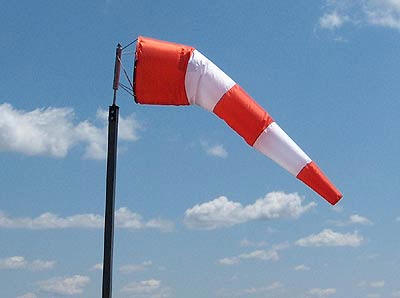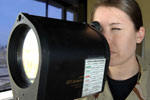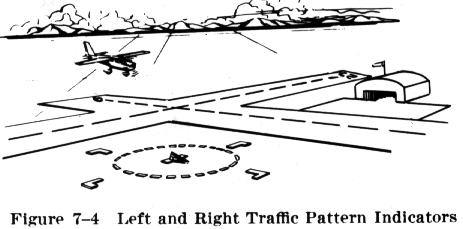An aircraft without radio communications remains out of the airport area and visually observes the traffic landing and departing. Additionally, the pilot looks for the wind sock or segmented circle, where available, to determine wind direction or direction of landing. The pilot enters the traffic pattern as recommended in the Aeronautical Information Manual and by regulation (14 CFR part 91, subpart B).
A basic rectangular traffic pattern is illustrated in Fig. 7-2. The traffic pattern altitude is usually 1,000 feet above the elevation of the airport surface. The use of a common altitude at a given airport is the key factor in minimizing the risk of collisions at nontower airports. At all airports, the direction of traffic flow (in accordance with FAR Part 91) is always to the left, unless right turns are indicated by approved light signals or visual markings on the airport, or the control tower specifically directs otherwise.
The basic rectangular traffic pattern consists of four "legs" positioned in relation to the runway in use. In the following discussion, reference is made to a "90 degree turn" from one leg to the other since the ground track of each leg is perpendicular to the preceding one. The actual change in the airplane's heading during those turns will be more or less than 90 degrees depending on the amount of correction necessary to counteract wind drift.
The upwind leg of the rectangular pattern is a straight course aligned with, and leading from, the takeoff runway. This leg begins at the point the airplane leaves the ground and continues until the 90 degree turn onto the crosswind leg is started.
On the upwind leg after takeoff, the pilot should continue climbing straight ahead until reaching a point beyond the departure end of the runway and within 300 feet of traffic pattern altitude. If leaving the pattern, the pilot should continue straight ahead, or depart by making a 45 degree left turn (right turn for a right-hand pattern).
The crosswind leg is the part of the rectangular pattern that is horizontally perpendicular to the extended centerline of the takeoff runway and is entered by making a 90 degree turn from the upwind leg. On the crosswind leg the airplane proceeds to the downwind leg position.
Since in most cases the takeoff is made into the wind, the wind now will be approximately perpendicular to the airplane's flightpath. As a result, the airplane will have to be crabbed or headed slightly into the wind while on the cross wind leg to maintain a ground track that is perpendicular to the runway centerline extension. This factor will be further explained in a later chapter covering wind drift and maneuvering by reference to ground objects.
After reaching the prescribed altitude for the traffic pattern and when in the proper position to enter the downwind leg, a level medium bank 90 degree turn should be made into the downwind leg.
The downwind leg is a course flown parallel to the landing runway, but in a direction opposite to the intended landing direction. This leg should be approximately 1/2 to 1 mile out from the landing runway, and at the specified traffic pattern altitude. During this leg, the prelanding check should be completed and the landing gear extended if retractable. The downwind leg continues past a point abeam of the approach end of the runway to where a medium bank 90 degree turn is made onto the base leg.
The base leg is the transitional part of the traffic pattern between the downwind leg and the final approach leg. Depending on the wind condition, it is established at a sufficient distance from the approach end of the landing runway to permit a gradual descent to the intended touchdown point. The ground track of the airplane while on the base leg should be perpendicular to the extended centerline of the landing runway, although the longitudinal axis of the airplane may not be aligned with the ground track when it is necessary to crab into the wind to counteract drift. (This will be discussed in the chapter on Landing Approaches and Landings.) While on the base leg the pilot must ensure, before turning onto the final approach, that there is no danger of colliding with another aircraft that may be already on the final approach.


|
|
Steady Green Signal
Aircraft on ground is cleared for
takeoff. Aircraft in flight is cleared to land. |
|
|
Flashing Green Signal
Aircraft on ground is cleared for
taxi. Aircraft in flight should return for landing (followed by
steady green). |
|
|
Steady Red Signal
Aircraft on ground must stop.
Aircraft in flight should give way to other aircraft and
continue circling. |
|
|
Flashing Red Signal
Aircraft on ground must taxi clear
of the runway in use. Aircraft in flight note that the airport
is unsafe, do not land. |
|
|
Flashing White Signal
Aircraft on ground must return to
starting point on airport. Not applicable for aircraft in
flight. |
|
|
Alternating Green & Red
All aircraft should exercise
extreme caution, on the ground or in flight. |

As stipulated in Federal Aviation Regulations, aircraft while on final approach to land, or while landing, have the right of way over other aircraft in flight or operating on the surface. When two or more aircraft are approaching an airport for the purpose of landing, the aircraft at the lower altitude has the right of way, but it shall not take advantage of this rule to cut in front of another which is on final approach to land, or to overtake that aircraft.
The final approach leg is a descending flightpath starting from the completion of the base to final turn and extending to the point of touchdown. This is probably the most important leg of the entire pattern, for here the pilot's judgment and technique must be keenest to accurately control the airspeed and decent angle while approaching the intended touchdown point. The various aspects are thoroughly explained in the chapter on Landing Approaches and Landings.
Also see other airport lighting for aid in and out of an airport as well taxing